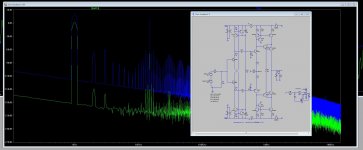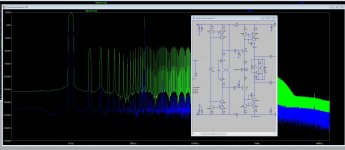
Eleven posts that are of little more than bickering between some of you have been deleted. You all know who you are... don't let it come to points or worse.
A pity this thread is quiet; there is much to say.
Here's the big question:
If we use high feedback to reduce distortion, do we produce an amp that is highly musical and yet is NOT an effects box.
And lastly:
If an amp is an effects box, is it popular with many audiophiles?
Here's the big question:
If we use high feedback to reduce distortion, do we produce an amp that is highly musical and yet is NOT an effects box.
And lastly:
If an amp is an effects box, is it popular with many audiophiles?
A pity this thread is quiet; there is much to say.
Why do I feel you wanted to say 'Pity it's gone quiet, I'll stir it up again" 🙂!
I could jump into preferences and how people like warm and euphonic, but given that some DBLTs show a preference to lower distortion I don't know.
What I can say is that it's marvellous that some on this forum are chasing distortion levels at the limits of measurements just for the challenge. And having fun. WNTL?
Could be GNF has nothing to do with anything at all (not even a little), ghosts and phantoms.
Member
Joined 2009
Paid Member
A pity this thread is quiet; there is much to say.
the male-hens need a rest before they get back in the ring...
If an amp is an effects box, is it popular with many audiophiles?
It'll be popular with some people but how to answer without first knowing
what is an audiophile ?
Bill,
This is evidently a controversial area; another minefield between the objectivists and the subjectivists. I do believe there is more to say.
Scott,
I do not disagree; in truth, I agree with everyone until the conclusion Is evident to everyone. Why do some amp topologies/layouts/component choices/operating points affect 'musicality', whatever that is? Will lowest THD universally deliver a wonderful amp that everyone is happy to hear? And if so, why does a 300B SET sound so good to some people regardless of very happy THD? Can we emulate the SET sound using opamp design? Can we do this?
Bigun,
An audiophile is someone who loves audio. A few of them love music too.
Did you mean **** fighting?
This is evidently a controversial area; another minefield between the objectivists and the subjectivists. I do believe there is more to say.
Scott,
I do not disagree; in truth, I agree with everyone until the conclusion Is evident to everyone. Why do some amp topologies/layouts/component choices/operating points affect 'musicality', whatever that is? Will lowest THD universally deliver a wonderful amp that everyone is happy to hear? And if so, why does a 300B SET sound so good to some people regardless of very happy THD? Can we emulate the SET sound using opamp design? Can we do this?
Bigun,
An audiophile is someone who loves audio. A few of them love music too.
Did you mean **** fighting?
Last edited:
Will lowest THD universally deliver a wonderful amp that everyone is happy to hear?
So far the lowest THD amps haven't universally impressed listeners so I'd venture 'no' to this.
There are plenty though for whom ultra-low THD figures are a placebo.
Member
Joined 2009
Paid Member
audiophile or not, I find there is a place for both ultra low Distortion amps and those designed carefully around certain distortion objectives. Examples being all over this forum for starters. You will find praise for the simple but subtly complex AKSA amp with a tailored distortion behaviour and equally praise for sophisticated low distortion amps. I dont see these as mutually exclusive options. There is an amp out there to suit everyone and every mood. Perhaps the male-hen fighting comes into play when trying to push our own preferences onto somebody else with different preferences, or denegrating them. As pointed out above, gnf may be the Red Herring here.
Isn't a major point of DIYA that there just isn't an amp out there to suit every DIYer which is why we're always creating new designs? True for me anyway.
This is an impossible discussion.
As soon as you start to say that this or that is more loved by music lovers / audiophiles / whatever than another amp / toploogy, sure some jump in and say that it's not a valid discussion.
The reasoning behind this is that in a controlled blind test no differences can be heard and no one proved otherwise (except those cases with very high distortion or with unmatched FR due to different output impedance).
So what? As long as there is always this fact discussed and not different topologies and other determining parts of the design, there will never be a discussion as Hugh would like.
As soon as you start to say that this or that is more loved by music lovers / audiophiles / whatever than another amp / toploogy, sure some jump in and say that it's not a valid discussion.
The reasoning behind this is that in a controlled blind test no differences can be heard and no one proved otherwise (except those cases with very high distortion or with unmatched FR due to different output impedance).
So what? As long as there is always this fact discussed and not different topologies and other determining parts of the design, there will never be a discussion as Hugh would like.
A pity this thread is quiet; there is much to say.
Here's the big question:
If we use high feedback to reduce distortion, do we produce an amp that is highly musical and yet is NOT an effects box.
And lastly:
If an amp is an effects box, is it popular with many audiophiles?
In my current project I attempt to have no single stage ever saturate or cut off (except for when the amp is clipping) combined with moderate feedback.
Too many "simple" designs rely on global feedback to give reasonable THD performance.
I try to not make effects boxes, if THD is needed I have a DSP front-end where the effects can be adjusted to whatever the user preference may be.
It has been shown that <10ppm THD is possible in real world designs, but I doubt this is the defining parameter for a good amp. THD & IMD should be low, but so should idle noise - a good 300W amp should not exceed 50µV RMS on the output with inputs shorted.
I think John Curl has said somewhere that the most important harmonic to suppress is the 7th - because it does not fit in.
\\\Jens
This may be of interest. Voltage gain-stage that has no global feedback loop also produces IMD... CFA's produce a lot. maybe this is why they sound thin and brittle to me, lacking warm slam that at least to me is a must in a good amplifier.
1Khz@2V and 0.5V@15 KHz driving signal.
1Khz@2V and 0.5V@15 KHz driving signal.
Attachments
It can also look like this... This is a VFA. evaluated on a single tone this has more THD than the CFA posted above.
Attachments
Last edited:
I have both VFA and CFA (3 CFA and 2 VFA)
The VFA distortion is as I reported a few weeks ago 28 ppm at 150W. The CFA's distortio in my case is much higher.
But they don't sound thin and brittle to my ears.
I would say looking at your plots that the harmonics are quite high.
The VFA distortion is as I reported a few weeks ago 28 ppm at 150W. The CFA's distortio in my case is much higher.
But they don't sound thin and brittle to my ears.
I would say looking at your plots that the harmonics are quite high.
This may be of interest. Voltage gain-stage that has no global feedback loop also produces IMD... CFA's produce a lot. maybe this is why they sound thin and brittle to me, lacking warm slam that at least to me is a must in a good amplifier.
1Khz@2V and 0.5V@15 KHz driving signal.
I really like the sound of a Current Feedback gain stage, similar to a folded cascode but better to myself. There are ways around the brittle sound you refer to, and can be made to sound ballsier than a VFA, the topology and dimensioning makes a difference. I find them unmatched in the presentation of highs and as long as you take care of any potential ringing they can sound just beautiful.
Colin
Member
Joined 2009
Paid Member
Isn't a major point of DIYA that there just isn't an amp out there to suit every DIYer which is why we're always creating new designs? True for me anyway.
No, I don't think so, at least what I see is that it's a rare addict that can't find an amplifier they like. Most people seem to keep building because they like the process of design, build, test, ... exploring. Look at the Pass forum, many build different Pass models, but most all of them say they like all the amps they build, all of them are suitable but they like to explore.... Others *seem* to build a few amps and then slow down because they've found something that suits them - and then focus on doing new stuff, speakers, pre-amps, wasting their lives on forums ... 😛
Perhaps audiophiles want a variety of things, like the recreation of a concert hall
experience in their living room, or hearing the string quartet they like without screechy coloration, or a human voice without too much sibilance. While a good amplifier may help the achievement of some of this, the main problem imo is the distortion of the transducers
also the acoustics of the room. Were you raised listening to a valve radio ? Maybe this is why you prefer SET amps. My childhood radiogram had a SET 2A3 amp......I didnt like it.
experience in their living room, or hearing the string quartet they like without screechy coloration, or a human voice without too much sibilance. While a good amplifier may help the achievement of some of this, the main problem imo is the distortion of the transducers
also the acoustics of the room. Were you raised listening to a valve radio ? Maybe this is why you prefer SET amps. My childhood radiogram had a SET 2A3 amp......I didnt like it.
No, I don't think so, at least what I see is that it's a rare addict that can't find an amplifier they like.
For me 'liking' something isn't too difficult, but the exploration process pulls me to mod it somehow, optimize it. I certainly enjoy stuff that I know isn't totally optimized but can't seem to kick the habit of wanting to get more out of a design.... Audiophiles are always looking for the next tweak, upgrade, add-on and I get that even though I'd not describe myself as an audiophile.
Yeah I think once I've got a totally optimized design for one part I'll move on to another part of the chain, as you say. Exploration is where its at 🙂
- Home
- Amplifiers
- Solid State
- Global Feedback - A huge benefit for audio


